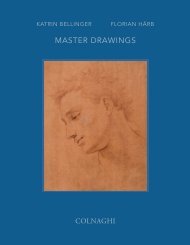2007 Catalogue - Colnaghi
2007 Catalogue - Colnaghi
2007 Catalogue - Colnaghi
Create successful ePaper yourself
Turn your PDF publications into a flip-book with our unique Google optimized e-Paper software.
Literature: To be included (and reproduced in colour)<br />
in the forthcoming catalogue raisonné of works by Paul<br />
Bril currently being prepared by Dr. Luuk Pijl .<br />
Recently discovered, this painting is an important<br />
addition to the oeuvre of Paul Bril. 1 The subject<br />
depicted comes from the late ancient Greek novel<br />
Historiae Aethiopicae by the Syrian Heliodorus. The<br />
story tells of the love affair of the Greek Theagenes and<br />
the Ethiopian Chariclea, a princess and priestess of<br />
Apollo. Theagenes has abducted Chariclea but while<br />
fleeing, the couple are taken captive by pirates, whose<br />
chief wants to take Chariclea for himself. However, at<br />
a feast on the Nile delta, the pirates end up quarrelling<br />
and kill each other (which is the scene depicted in the<br />
middle distance). Theagenes is wounded in the fight,<br />
and when a band of brigands comes upon them, the<br />
couple are taken captive, once again, while the robbers<br />
plunder the ship. A second group of brigands appear<br />
and, having driven the first band away, take the young<br />
lovers to their nearby village, which is the main scene<br />
in this work. After numerous vicissitudes, the story<br />
ends happily with the marriage of the couple.<br />
Although virtually unknown today, the Historiae<br />
Aethiopicae was popular in the sixteenth and<br />
seventeenth centuries. A French translation appeared<br />
from 1547 onwards in several editions, and an<br />
important edition with engravings by Crispijn van de<br />
Passe appeared in Paris in 1624. The subject was<br />
thought to be suitable for palace decorations; in the<br />
King’s apartment at Fontainebleau the story was<br />
depicted by Ambroise Dubois in 1609/10, and in<br />
1625 Abraham Bloemaert was commissioned by<br />
Frederik Hendrik of Nassau, Prince of Orange, to<br />
paint the story on the occasion of his marriage with<br />
Amalia van Solms. Bloemaert’s Theagenes and<br />
Chariclea among the Slain Sailors, now in Potsdam,<br />
Sanssouci, shows the scene on the beach, which is<br />
rendered in Bril’s painting in the middle distance. 2<br />
01<br />
Paul Bril<br />
(Breda 1553/54 – 1626 Rome)<br />
An extensive mountainous coastal Landscape<br />
with Brigands abducting Theagenes and Chariclea<br />
Oil on canvas<br />
41 3 /8 x 58 1 /4 in. (105 x 148 cm.)<br />
19<br />
Noting stylistic similarities with works Bril painted<br />
during the last years of his prolific life, such as the fine<br />
Landscape with Nymphs and Satyrs in Oberlin, dated<br />
1623, and the Landscape with the Temptation of Christ<br />
in Birmingham, dated 1626, we can date our painting<br />
to around 1625. 3 As Dr. Pijl notes, the <strong>Colnaghi</strong><br />
picture demonstrates that Bril was a master of<br />
observation. Many details are meticulously rendered,<br />
from the plants and trees to the sunset and harbour in<br />
the distance. The alternating zones of dark and light<br />
give the landscape a clear structure and also provide a<br />
convincing suggestion of depth. Although Bril often<br />
relied on Northern and Italian figure painters for the<br />
staffage in his landscapes, 4 the figures in the present<br />
work are stylistically in keeping with his own way of<br />
figure painting. They are unusually large in size: no<br />
other painting with figures of this scale is extant, which<br />
makes our painting even more important among Bril’s<br />
late works.<br />
Paul Bril was born in Antwerp in 1554. After his<br />
training there he left for Lyon (1574) and settled in<br />
Rome by 1582, where he spent the rest of his life. In<br />
Rome from 1590 on, Paul Bril created small landscapes<br />
on copper which are a synthesis of the late mannerist<br />
landscapes invented by Gillis III van Coninxloo and<br />
continued by Martin de Vos, Jan Brueghel the Elder’s<br />
velvet adoption of the same source, Saedeleer’s<br />
engravings, and Joos de Momper’s alpine landscapes.<br />
Most figures in Bril’s landscapes were painted by fellow<br />
artists who were also often northern residents in Rome:<br />
Elsheimer, Rottenhamer and Rubens. These small<br />
landscapes were, for Bril, a huge artistic and<br />
commercial success both in Italy and in Flanders. He<br />
worked in Rome for important patrons, including<br />
Popes Gregory XIII, Sixtus V and Clement VIII and<br />
Cardinals Sfondrato, Borromée, Scipione Borghese,<br />
del Nero and Matei and members of their respective<br />
families.








